2009 NISSAN ALTIMA COUPE tire type
[x] Cancel search: tire typePage 332 of 373
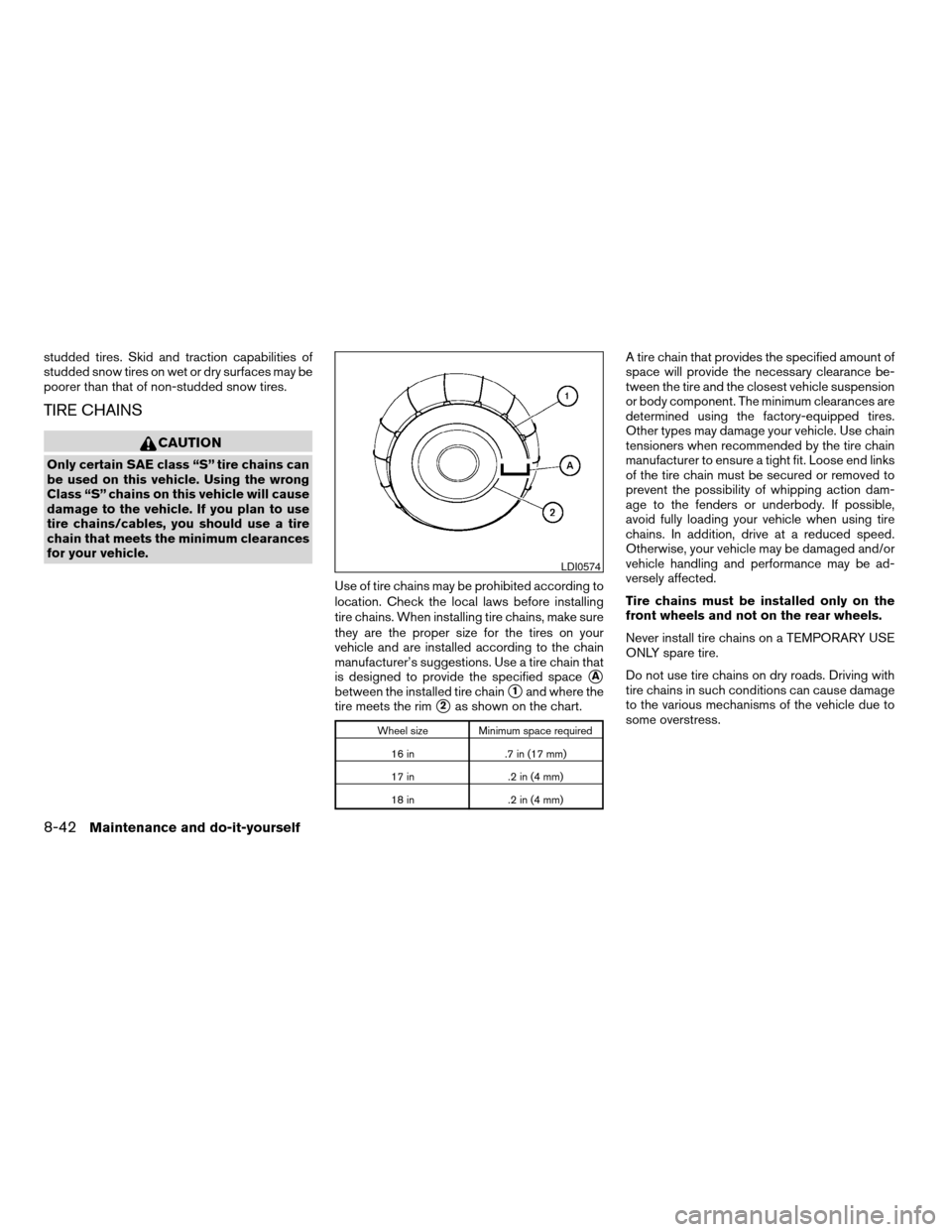
studded tires. Skid and traction capabilities of
studded snow tires on wet or dry surfaces may be
poorer than that of non-studded snow tires.
TIRE CHAINS
CAUTION
Only certain SAE class “S” tire chains can
be used on this vehicle. Using the wrong
Class “S” chains on this vehicle will cause
damage to the vehicle. If you plan to use
tire chains/cables, you should use a tire
chain that meets the minimum clearances
for your vehicle.
Use of tire chains may be prohibited according to
location. Check the local laws before installing
tire chains. When installing tire chains, make sure
they are the proper size for the tires on your
vehicle and are installed according to the chain
manufacturer’s suggestions. Use a tire chain that
is designed to provide the specified space
sA
between the installed tire chains1and where the
tire meets the rim
s2as shown on the chart.
Wheel size Minimum space required
16 in .7 in (17 mm)
17 in .2 in (4 mm)
18 in .2 in (4 mm)
A tire chain that provides the specified amount of
space will provide the necessary clearance be-
tween the tire and the closest vehicle suspension
or body component. The minimum clearances are
determined using the factory-equipped tires.
Other types may damage your vehicle. Use chain
tensioners when recommended by the tire chain
manufacturer to ensure a tight fit. Loose end links
of the tire chain must be secured or removed to
prevent the possibility of whipping action dam-
age to the fenders or underbody. If possible,
avoid fully loading your vehicle when using tire
chains. In addition, drive at a reduced speed.
Otherwise, your vehicle may be damaged and/or
vehicle handling and performance may be ad-
versely affected.
Tire chains must be installed only on the
front wheels and not on the rear wheels.
Never install tire chains on a TEMPORARY USE
ONLY spare tire.
Do not use tire chains on dry roads. Driving with
tire chains in such conditions can cause damage
to the various mechanisms of the vehicle due to
some overstress.
LDI0574
8-42Maintenance and do-it-yourself
ZREVIEW COPYÐ2009 Altima(alt)
Owners Manual(owners)ÐUSA_English(nna)
02/03/09Ðdebbie
X
Page 334 of 373
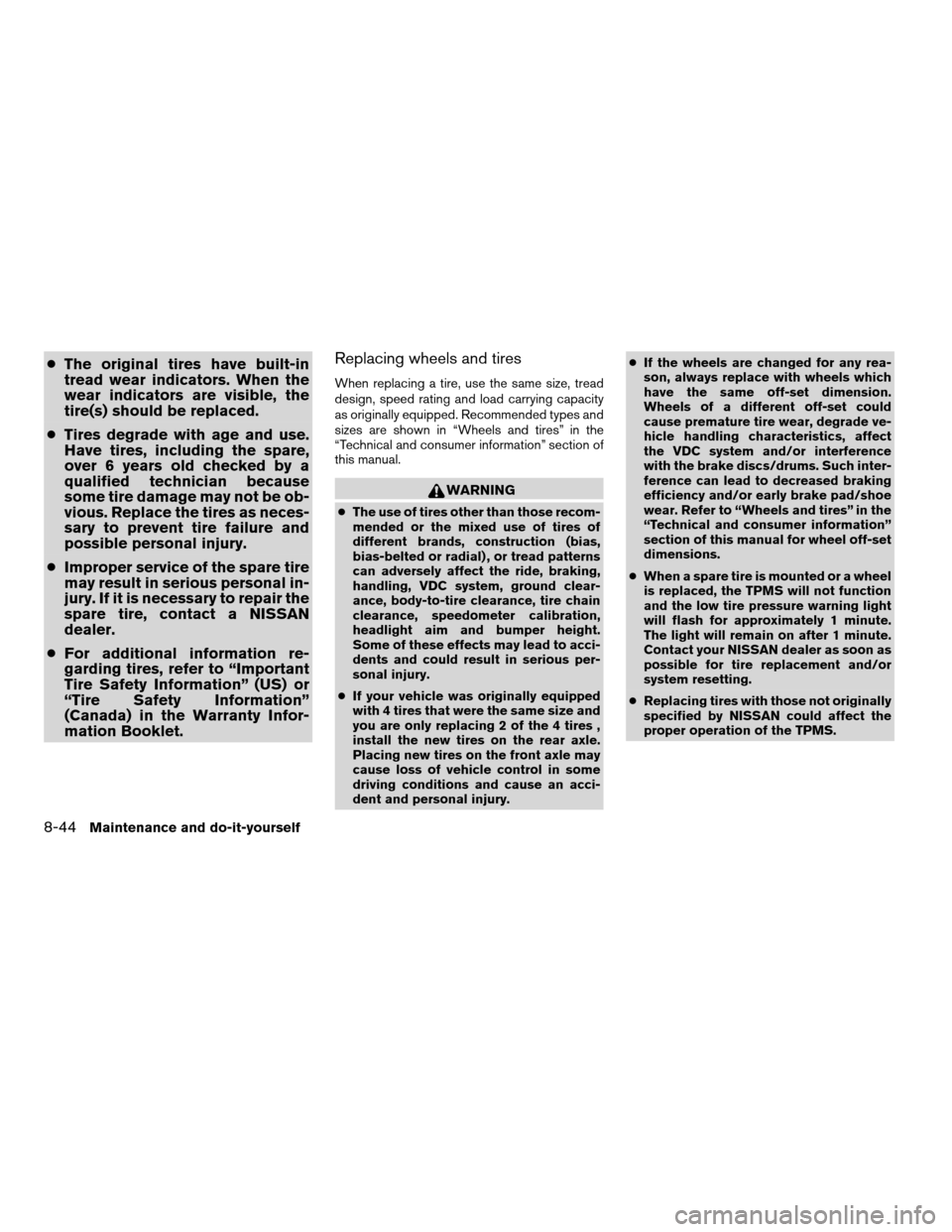
cThe original tires have built-in
tread wear indicators. When the
wear indicators are visible, the
tire(s) should be replaced.
cTires degrade with age and use.
Have tires, including the spare,
over 6 years old checked by a
qualified technician because
some tire damage may not be ob-
vious. Replace the tires as neces-
sary to prevent tire failure and
possible personal injury.
cImproper service of the spare tire
may result in serious personal in-
jury. If it is necessary to repair the
spare tire, contact a NISSAN
dealer.
cFor additional information re-
garding tires, refer to “Important
Tire Safety Information” (US) or
“Tire Safety Information”
(Canada) in the Warranty Infor-
mation Booklet.Replacing wheels and tires
When replacing a tire, use the same size, tread
design, speed rating and load carrying capacity
as originally equipped. Recommended types and
sizes are shown in “Wheels and tires” in the
“Technical and consumer information” section of
this manual.
WARNING
cThe use of tires other than those recom-
mended or the mixed use of tires of
different brands, construction (bias,
bias-belted or radial) , or tread patterns
can adversely affect the ride, braking,
handling, VDC system, ground clear-
ance, body-to-tire clearance, tire chain
clearance, speedometer calibration,
headlight aim and bumper height.
Some of these effects may lead to acci-
dents and could result in serious per-
sonal injury.
cIf your vehicle was originally equipped
with 4 tires that were the same size and
you are only replacing 2 of the 4 tires ,
install the new tires on the rear axle.
Placing new tires on the front axle may
cause loss of vehicle control in some
driving conditions and cause an acci-
dent and personal injury.cIf the wheels are changed for any rea-
son, always replace with wheels which
have the same off-set dimension.
Wheels of a different off-set could
cause premature tire wear, degrade ve-
hicle handling characteristics, affect
the VDC system and/or interference
with the brake discs/drums. Such inter-
ference can lead to decreased braking
efficiency and/or early brake pad/shoe
wear. Refer to “Wheels and tires” in the
“Technical and consumer information”
section of this manual for wheel off-set
dimensions.
cWhen a spare tire is mounted or a wheel
is replaced, the TPMS will not function
and the low tire pressure warning light
will flash for approximately 1 minute.
The light will remain on after 1 minute.
Contact your NISSAN dealer as soon as
possible for tire replacement and/or
system resetting.
cReplacing tires with those not originally
specified by NISSAN could affect the
proper operation of the TPMS.
8-44Maintenance and do-it-yourself
ZREVIEW COPYÐ2009 Altima(alt)
Owners Manual(owners)ÐUSA_English(nna)
02/03/09Ðdebbie
X
Page 344 of 373
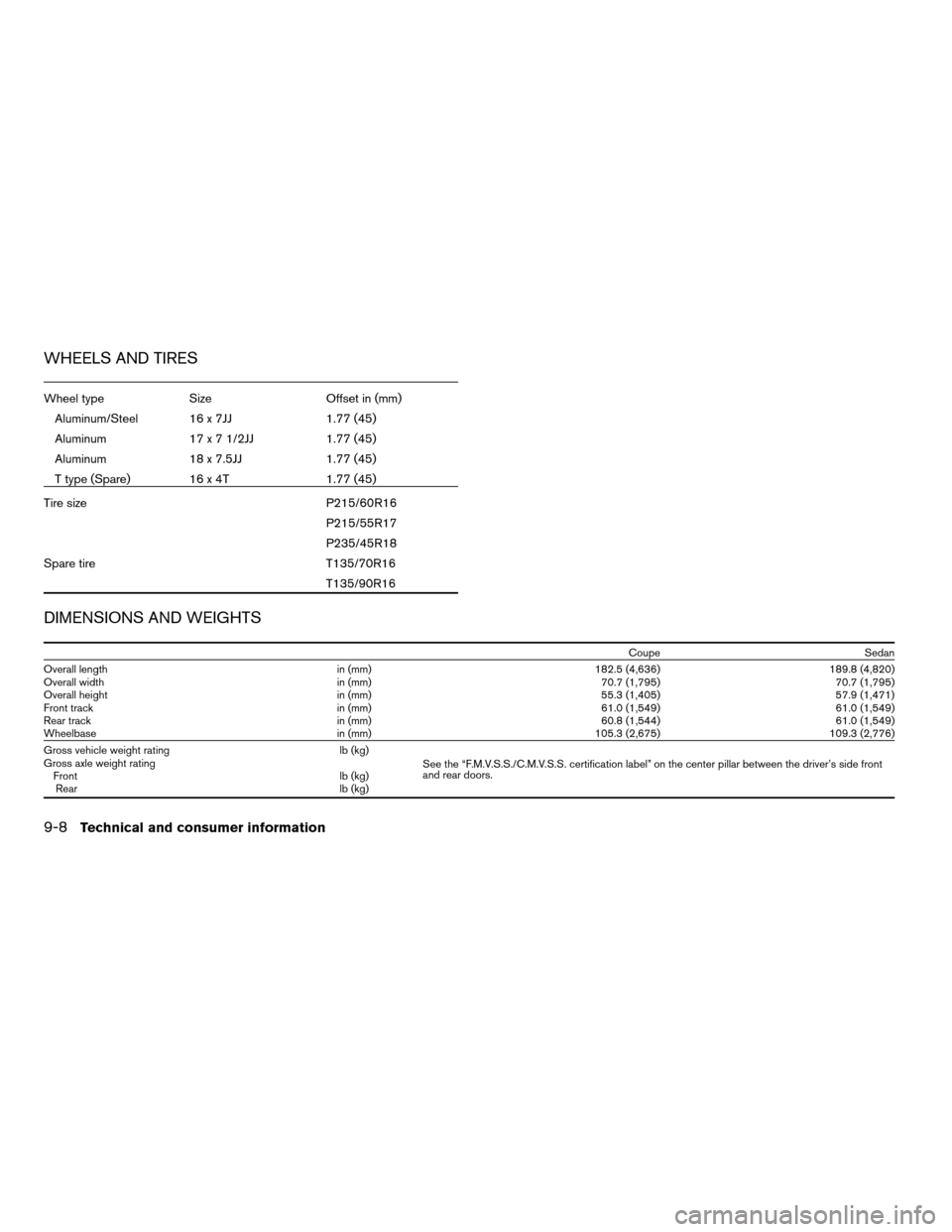
WHEELS AND TIRES
Wheel type Size Offset in (mm)
Aluminum/Steel 16 x 7JJ 1.77 (45)
Aluminum 17 x 7 1/2JJ 1.77 (45)
Aluminum 18 x 7.5JJ 1.77 (45)
T type (Spare) 16 x 4T 1.77 (45)
Tire size P215/60R16
P215/55R17
P235/45R18
Spare tire T135/70R16
T135/90R16
DIMENSIONS AND WEIGHTS
Coupe Sedan
Overall length in (mm) 182.5 (4,636) 189.8 (4,820)
Overall width in (mm) 70.7 (1,795) 70.7 (1,795)
Overall height in (mm) 55.3 (1,405) 57.9 (1,471)
Front track in (mm) 61.0 (1,549) 61.0 (1,549)
Rear track in (mm) 60.8 (1,544) 61.0 (1,549)
Wheelbase in (mm) 105.3 (2,675) 109.3 (2,776)
Gross vehicle weight rating lb (kg)
See the “F.M.V.S.S./C.M.V.S.S. certification label” on the center pillar between the driver’s side front
and rear doors. Gross axle weight rating
Front lb (kg)
Rear lb (kg)
9-8Technical and consumer information
ZREVIEW COPYÐ2009 Altima(alt)
Owners Manual(owners)ÐUSA_English(nna)
02/03/09Ðdebbie
X
Page 356 of 373
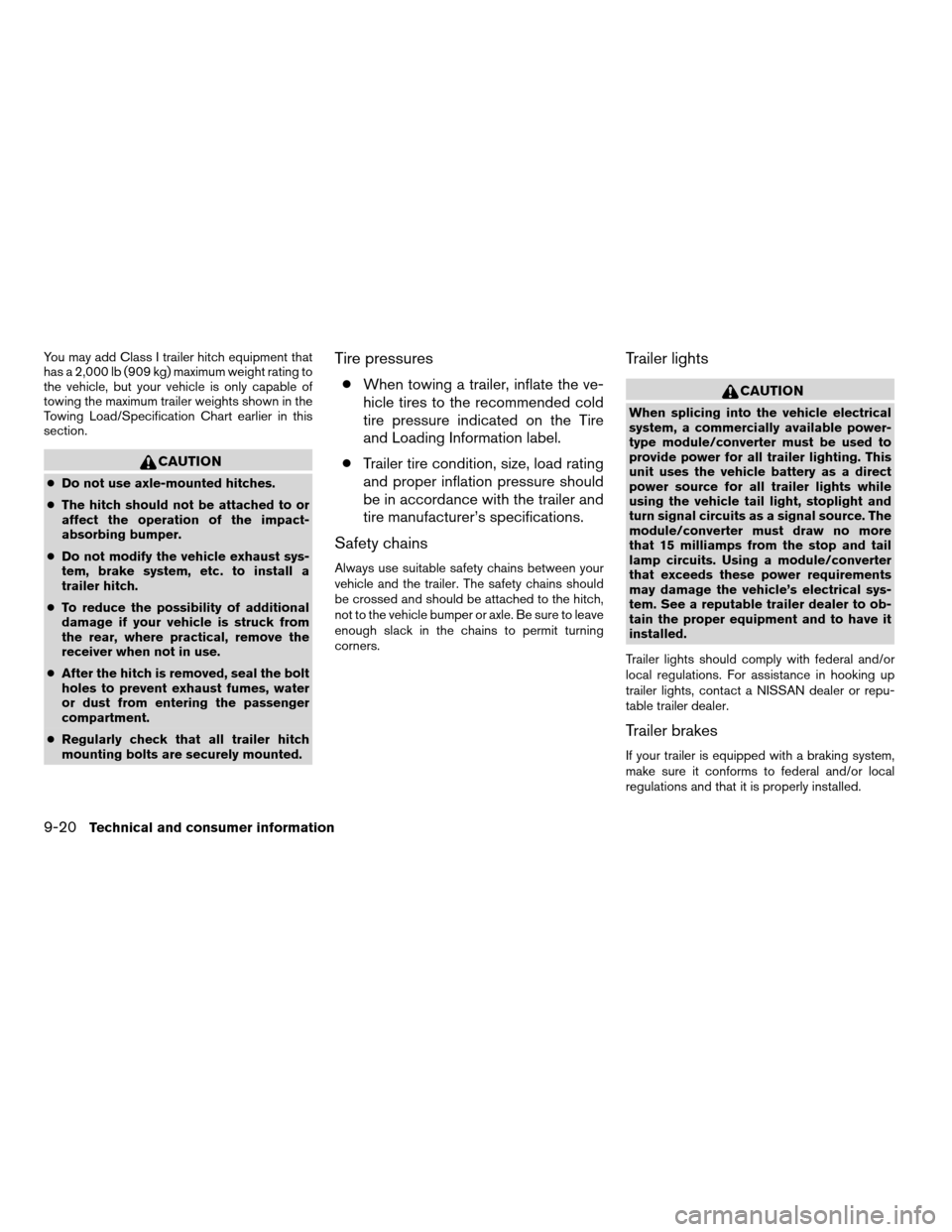
You may add Class I trailer hitch equipment that
has a 2,000 lb (909 kg) maximum weight rating to
the vehicle, but your vehicle is only capable of
towing the maximum trailer weights shown in the
Towing Load/Specification Chart earlier in this
section.
CAUTION
cDo not use axle-mounted hitches.
cThe hitch should not be attached to or
affect the operation of the impact-
absorbing bumper.
cDo not modify the vehicle exhaust sys-
tem, brake system, etc. to install a
trailer hitch.
cTo reduce the possibility of additional
damage if your vehicle is struck from
the rear, where practical, remove the
receiver when not in use.
cAfter the hitch is removed, seal the bolt
holes to prevent exhaust fumes, water
or dust from entering the passenger
compartment.
cRegularly check that all trailer hitch
mounting bolts are securely mounted.
Tire pressures
cWhen towing a trailer, inflate the ve-
hicle tires to the recommended cold
tire pressure indicated on the Tire
and Loading Information label.
cTrailer tire condition, size, load rating
and proper inflation pressure should
be in accordance with the trailer and
tire manufacturer’s specifications.
Safety chains
Always use suitable safety chains between your
vehicle and the trailer. The safety chains should
be crossed and should be attached to the hitch,
not to the vehicle bumper or axle. Be sure to leave
enough slack in the chains to permit turning
corners.
Trailer lights
CAUTION
When splicing into the vehicle electrical
system, a commercially available power-
type module/converter must be used to
provide power for all trailer lighting. This
unit uses the vehicle battery as a direct
power source for all trailer lights while
using the vehicle tail light, stoplight and
turn signal circuits as a signal source. The
module/converter must draw no more
that 15 milliamps from the stop and tail
lamp circuits. Using a module/converter
that exceeds these power requirements
may damage the vehicle’s electrical sys-
tem. See a reputable trailer dealer to ob-
tain the proper equipment and to have it
installed.
Trailer lights should comply with federal and/or
local regulations. For assistance in hooking up
trailer lights, contact a NISSAN dealer or repu-
table trailer dealer.
Trailer brakes
If your trailer is equipped with a braking system,
make sure it conforms to federal and/or local
regulations and that it is properly installed.
9-20Technical and consumer information
ZREVIEW COPYÐ2009 Altima(alt)
Owners Manual(owners)ÐUSA_English(nna)
02/03/09Ðdebbie
X
Page 357 of 373
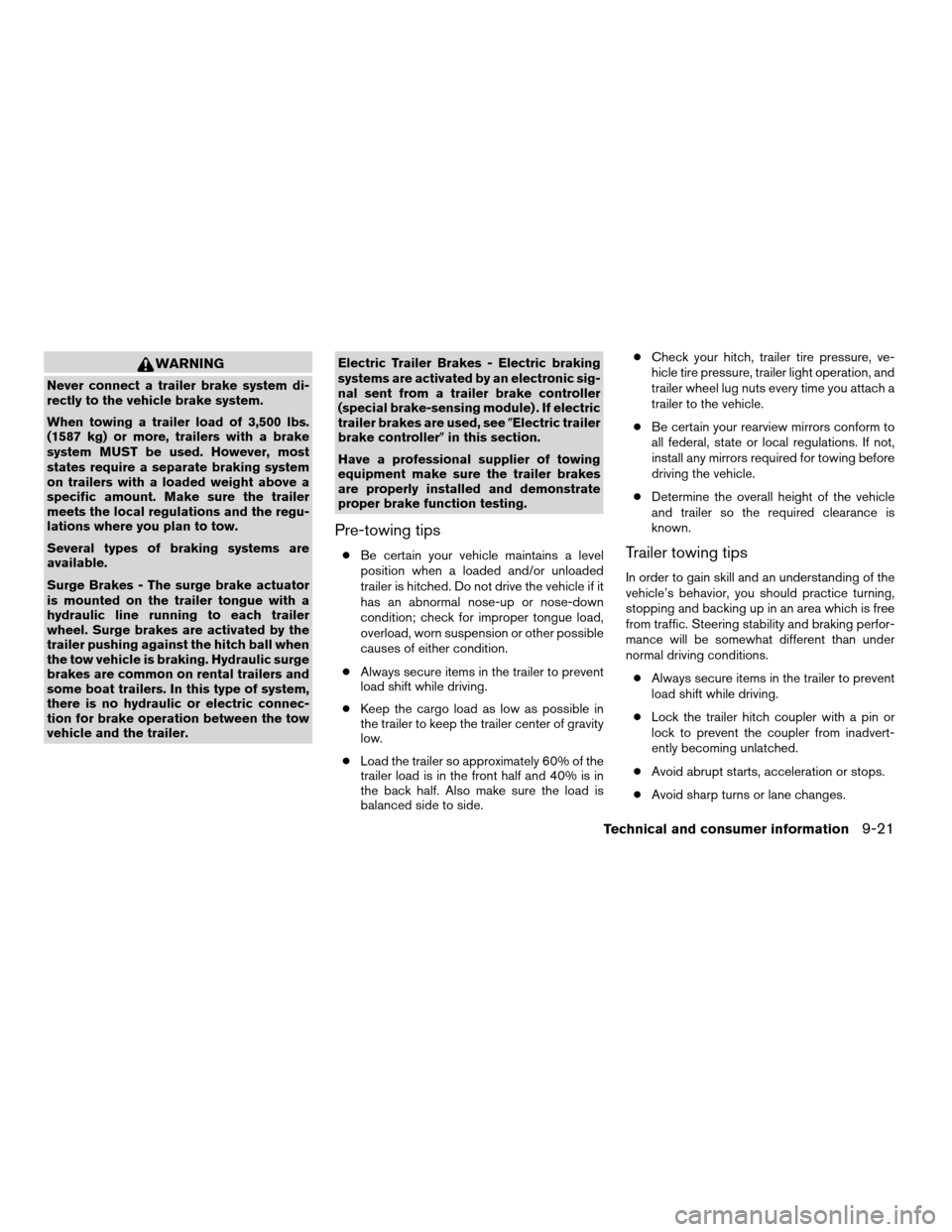
WARNING
Never connect a trailer brake system di-
rectly to the vehicle brake system.
When towing a trailer load of 3,500 lbs.
(1587 kg) or more, trailers with a brake
system MUST be used. However, most
states require a separate braking system
on trailers with a loaded weight above a
specific amount. Make sure the trailer
meets the local regulations and the regu-
lations where you plan to tow.
Several types of braking systems are
available.
Surge Brakes - The surge brake actuator
is mounted on the trailer tongue with a
hydraulic line running to each trailer
wheel. Surge brakes are activated by the
trailer pushing against the hitch ball when
the tow vehicle is braking. Hydraulic surge
brakes are common on rental trailers and
some boat trailers. In this type of system,
there is no hydraulic or electric connec-
tion for brake operation between the tow
vehicle and the trailer.Electric Trailer Brakes - Electric braking
systems are activated by an electronic sig-
nal sent from a trailer brake controller
(special brake-sensing module) . If electric
trailer brakes are used, see(Electric trailer
brake controller(in this section.
Have a professional supplier of towing
equipment make sure the trailer brakes
are properly installed and demonstrate
proper brake function testing.
Pre-towing tips
cBe certain your vehicle maintains a level
position when a loaded and/or unloaded
trailer is hitched. Do not drive the vehicle if it
has an abnormal nose-up or nose-down
condition; check for improper tongue load,
overload, worn suspension or other possible
causes of either condition.
cAlways secure items in the trailer to prevent
load shift while driving.
cKeep the cargo load as low as possible in
the trailer to keep the trailer center of gravity
low.
cLoad the trailer so approximately 60% of the
trailer load is in the front half and 40% is in
the back half. Also make sure the load is
balanced side to side.cCheck your hitch, trailer tire pressure, ve-
hicle tire pressure, trailer light operation, and
trailer wheel lug nuts every time you attach a
trailer to the vehicle.
cBe certain your rearview mirrors conform to
all federal, state or local regulations. If not,
install any mirrors required for towing before
driving the vehicle.
cDetermine the overall height of the vehicle
and trailer so the required clearance is
known.Trailer towing tips
In order to gain skill and an understanding of the
vehicle’s behavior, you should practice turning,
stopping and backing up in an area which is free
from traffic. Steering stability and braking perfor-
mance will be somewhat different than under
normal driving conditions.
cAlways secure items in the trailer to prevent
load shift while driving.
cLock the trailer hitch coupler with a pin or
lock to prevent the coupler from inadvert-
ently becoming unlatched.
cAvoid abrupt starts, acceleration or stops.
cAvoid sharp turns or lane changes.
Technical and consumer information9-21
ZREVIEW COPYÐ2009 Altima(alt)
Owners Manual(owners)ÐUSA_English(nna)
02/03/09Ðdebbie
X
Page 370 of 373
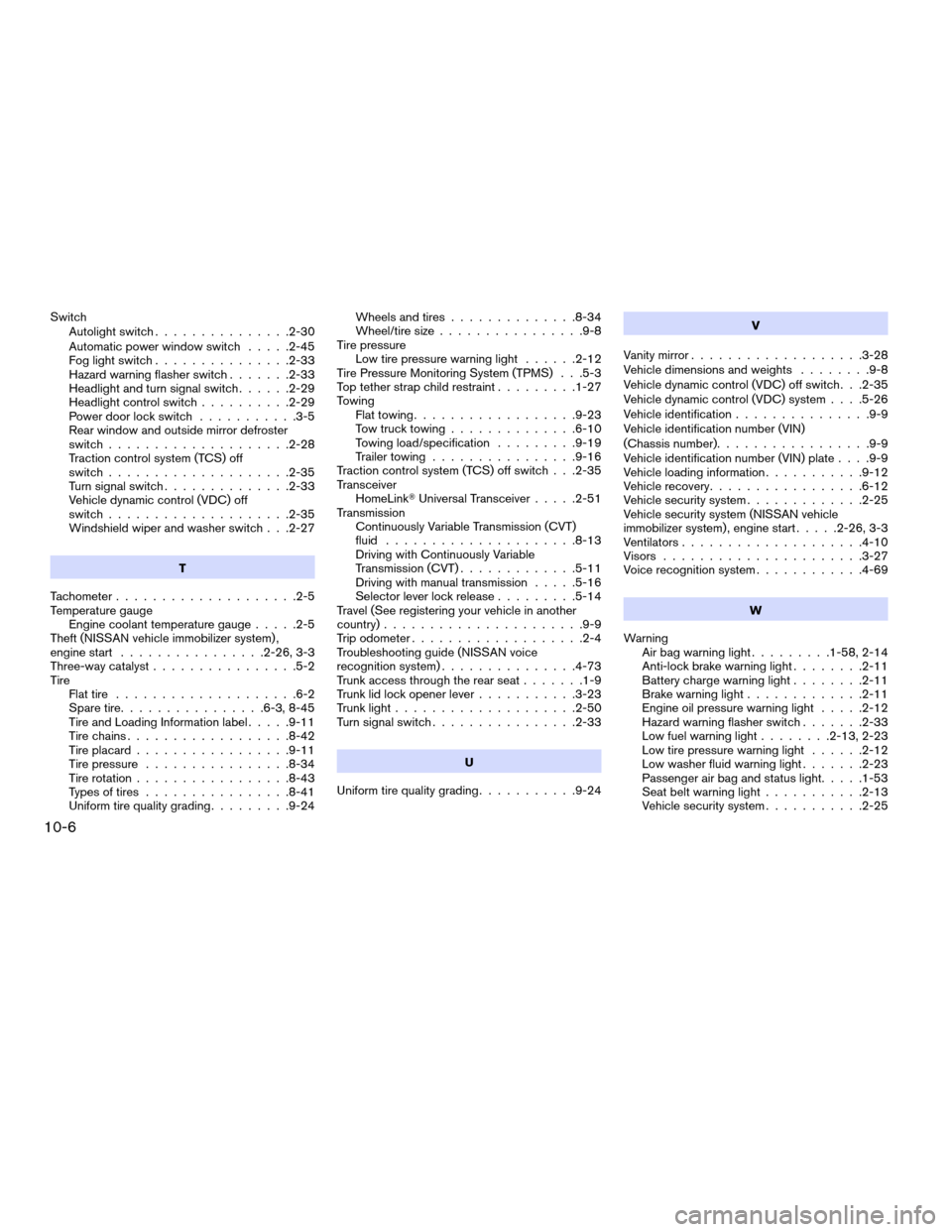
Switch
Autolight switch...............2-30
Automatic power window switch.....2-45
Fog light switch...............2-33
Hazard warning flasher switch.......2-33
Headlight and turn signal switch......2-29
Headlight control switch..........2-29
Power door lock switch...........3-5
Rear window and outside mirror defroster
switch....................2-28
Traction control system (TCS) off
switch....................2-35
Turn signal switch..............2-33
Vehicle dynamic control (VDC) off
switch....................2-35
Windshield wiper and washer switch . . .2-27
T
Tachometer....................2-5
Temperature gauge
Engine coolant temperature gauge.....2-5
Theft (NISSAN vehicle immobilizer system) ,
engine start................2-26, 3-3
Three-way catalyst................5-2
Tire
Flat tire....................6-2
Spare tire................6-3, 8-45
Tire and Loading Information label.....9-11
Tire chains..................8-42
Tire placard.................9-11
Tire pressure................8-34
Tire rotation.................8-43
Types of tires................8-41
Uniform tire quality grading.........9-24Wheels and tires..............8-34
Wheel/tire size................9-8
Tire pressure
Low tire pressure warning light......2-12
Tire Pressure Monitoring System (TPMS) . . .5-3
Top tether strap child restraint.........1-27
Towing
Flat towing..................9-23
Tow truck towing..............6-10
Towing load/specification.........9-19
Trailer towing................9-16
Traction control system (TCS) off switch . . .2-35
Transceiver
HomeLinkTUniversal Transceiver.....2-51
Transmission
Continuously Variable Transmission (CVT)
fluid.....................8-13
Driving with Continuously Variable
Transmission (CVT).............5-11
Driving with manual transmission.....5-16
Selector lever lock release.........5-14
Travel (See registering your vehicle in another
country)......................9-9
Trip odometer...................2-4
Troubleshooting guide (NISSAN voice
recognition system)...............4-73
Trunk access through the rear seat.......1-9
Trunk lid lock opener lever...........3-23
Trunk light....................2-50
Turn signal switch................2-33
U
Uniform tire quality grading...........9-24V
Vanity mirror...................3-28
Vehicle dimensions and weights........9-8
Vehicle dynamic control (VDC) off switch. . .2-35
Vehicle dynamic control (VDC) system. . . .5-26
Vehicle identification...............9-9
Vehicle identification number (VIN)
(Chassis number).................9-9
Vehicle identification number (VIN) plate. . . .9-9
Vehicle loading information...........9-12
Vehicle recovery.................6-12
Vehicle security system.............2-25
Vehicle security system (NISSAN vehicle
immobilizer system) , engine start.....2-26, 3-3
Ventilators....................4-10
Visors......................3-27
Voice recognition system............4-69
W
Warning
Air bag warning light.........1-58, 2-14
Anti-lock brake warning light........2-11
Battery charge warning light........2-11
Brake warning light.............2-11
Engine oil pressure warning light.....2-12
Hazard warning flasher switch.......2-33
Low fuel warning light........2-13, 2-23
Low tire pressure warning light......2-12
Low washer fluid warning light.......2-23
Passenger air bag and status light.....1-53
Seat belt warning light...........2-13
Vehicle security system...........2-25
10-6
ZREVIEW COPYÐ2009 Altima(alt)
Owners Manual(owners)ÐUSA_English(nna)
02/03/09Ðdebbie
X